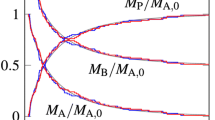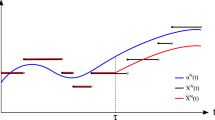Abstract
This work reviews deterministic and diffusion approximations of the stochastic chemical reaction networks and explains their applications. We discuss the added value the diffusion approximation provides for systems with different phenomena, such as a deficiency and a bistability. It is advocated that the diffusion approximation can be considered as an alternative theoretical approach to study the reaction networks rather than a simulation shortcut. We discuss two examples in which the diffusion approximation is able to catch qualitative properties of reaction networks that the deterministic model misses. We provide an explicit construction of the original process and the diffusion approximation such that the distance between their trajectories is controlled and demonstrate this construction for the examples. We also discuss the limitations and potential directions of the developments.







Similar content being viewed by others
References
Anderson D, Enciso G, Johnston M (2014) Stochastic analysis of biochemical reaction networks with absolute concentration robustness. J R Soc Interface 11(93) https://doi.org/10.1098/rsif.2013.0943
Anderson DF, Cappelletti D, Koyama M, Kurtz TG (2017) Non-explosivity of stochastically modeled reaction networks that are complex balanced. arXiv preprint arXiv:1708.09356
Anderson DF, Cappelletti D, Kurtz TG (2017) Finite time distributions of stochastically modeled chemical systems with absolute concentration robustness. SIAM J Appl Dyn Syst 16(3):1309–1339
Anderson DF, Craciun G, Kurtz TG (2010) Product-form stationary distributions for deficiency zero chemical reaction networks. Bull Math Biol 72(8):1947–1970
Anderson DF, Kurtz TG (2015) Stochastic analysis of biochemical systems. Mathematical biosciences Institute lecture series. Stochastics in biological systems, vol 1. Springer, MBI Mathematical Biosciences Institute, Ohio State University, Cham. https://doi.org/10.1007/978-3-319-16895-1
Angius A, Balbo G, Beccuti M, Bibbona E, Horvath A, Sirovich R (2015) Approximate analysis of biological systems by hybrid switching jump diffusion. Theor Comput Sci 587:49–72
Baxendale PH, Greenwood PE (2011) Sustained oscillations for density dependent markov processes. J Math Biol 63(3):433–457
Beccuti M, Bibbona E, Horváth A, Sirovich R, Angius A, Balbo G (2014) Analysis of Petri net models through stochastic differential equation. In: Proc. of international conference on application and theory of Petri nets and other models of concurrency (ICATPN’14), Tunis, Tunisia
Brémaud, P.: Point processes and queues. Martingale dynamics. Springer series in statistics. Springer, New York (1981).
Cappelletti D, Wiuf C (2016) Product-form poisson-like distributions and complex balanced reaction systems. SIAM J Appl Math 76(1):411–432. https://doi.org/10.1137/15M1029916
Csörgő M, Révész P (1975) A new method to prove strassen type laws of invariance principle. 1. Zeitschrift für Wahrscheinlichkeitstheorie und verwandte Gebiete 31(4):255–259
E. Bibbona R (2017) Strong approximation of density dependent markov chains on bounded domains. ArXiv:1704.07481
Érdi P, Lente G (2014) Stochastic chemical kinetics. Springer series in synergetics. Springer, New York. https://doi.org/10.1007/978-1-4939-0387-0. Theory and (mostly) systems biological applications
Érdi P, Tóth J (1989) Mathematical models of chemical reactions. Nonlinear science: theory and applications. Princeton University Press, Princeton, NJ. Theory and applications of deterministic and stochastic models
Ethier SN, Kurtz TG (1986) Markov processes. Wiley series in probability and mathematical statistics: probability and mathematical statistics. Wiley, New York. https://doi.org/10.1002/9780470316658. Characterization and convergence
Feinberg M (1972) On chemical kinetics of a certain class. Arch Ration Mech Anal 46(1):1–41
Feliu E, Wiuf C (2015) Finding the positive feedback loops underlying multi-stationarity. BMC Syst Biol 9(1). https://doi.org/10.1186/s12918-015-0164-0
Gillespie DT (1977) Exact stochastic simulation of coupled chemical reactions. J Phys Chem 81(25):2340–2361
Gillespie DT (2000) The chemical langevin equation. J Chem Phys 113(1):297–306. https://doi.org/10.1063/1.481811
Jahnke T, Huisinga W (2007) Solving the chemical master equation for monomolecular reaction systems analytically. J Math Biol 54(1):1–26
Joshi B, Shiu A (2013) Atoms of multistationarity in chemical reaction networks. J Math Chem 51(1):153–178
Komlós J, Major P, Tusnády G (1975) An approximation of partial sums of independent \({\rm RV}\)’s and the sample \({\rm DF}\). I Z Wahrscheinlichkeitstheorie und Verw. Gebiete 32:111–131
Kurtz TG (1970) Solutions of ordinary differential equations as limits of pure jump Markov processes. J Appl Probab. 7:49–58
Kurtz TG (1972) The relationship between stochastic and deterministic models for chemical reactions. J Chem Phys 57(7):2976–2978. https://doi.org/10.1063/1.1678692
Kurtz TG (1976) Limit theorems and diffusion approximations for density dependent Markov chains. Springer, Berlin, pp 67–78
Leite SC, Williams RJ (2017) A constrained langevin approximation for chemical reaction network. http://www.math.ucsd.edu/~williams/biochem/biochem.html
Øksendal B (2003) Stochastic differential equations, 6th ed. Universitext. Springer, Berlin. https://doi.org/10.1007/978-3-642-14394-6. An introduction with applications
Polettini M, Wachtel A, Esposito M (2005) Dissipation in noisy chemical networks: the role of deficiency. J Chem Phys 143(18), 11B606_1
R Core Team (2017) R: a language and environment for statistical computing. R Foundation for Statistical Computing, Vienna, Austria. https://www.R-project.org/
Santillán M (2014) Chemical kinetics, stochastic processes, and irreversible thermodynamics. Lecture notes on mathematical modelling in the life sciences. Springer, Cham. https://doi.org/10.1007/978-3-319-06689-9
Schlögl F (1972) Chemical reaction models for non-equilibrium phase transitions. Zeitschrift für Physik A Hadrons and Nuclei 253(2):147–161
Schnoerr D, Sanguinetti G, Grima R (2014) The complex chemical langevin equation. J Chem Phys 141(2):024103. https://doi.org/10.1063/1.4885345
Schnoerr D, Sanguinetti G, Grima R (2017) Approximation and inference methods for stochastic biochemical kinetics—a tutorial review. J Phys A 50(9). https://doi.org/10.1088/1751-8121/aa54d9
Stewart WJ (1994) Introduction to the numerical solutions of Markov chains. Princeton Univ, Press
Strassen V et al (1967) Almost sure behavior of sums of independent random variables and martingales. In: Proceedings of the fifth Berkeley symposium on mathematical statistics and probability. Contributions to probability theory, Part 1, vol 2. The Regents of the University of California
Ullah M, Wolkenhauer O (2011) Stochastic approaches for systems biology. Springer, New York. https://doi.org/10.1007/978-1-4614-0478-1
Wilhelm T (2009) The smallest chemical reaction system with bistability. BMC Syst Biol 3(1):90
Funding
P. Mozgunov and T. Jaki have received funding from the European Union‘s Horizon 2020 research and innovation programme under the Marie Sklodowska-Curie Grant Agreement No 633567.
Author information
Authors and Affiliations
Corresponding author
Rights and permissions
About this article
Cite this article
Mozgunov, P., Beccuti, M., Horvath, A. et al. A review of the deterministic and diffusion approximations for stochastic chemical reaction networks. Reac Kinet Mech Cat 123, 289–312 (2018). https://doi.org/10.1007/s11144-018-1351-y
Received:
Accepted:
Published:
Issue Date:
DOI: https://doi.org/10.1007/s11144-018-1351-y




